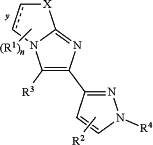| CPC C07D 519/00 (2013.01) [C07D 498/04 (2013.01); C07D 513/04 (2013.01)] | 19 Claims |
|
1. A compound of Formula (I):
 or a pharmaceutically acceptable salt, hydrate, or solvate thereof, wherein:
R1 is:
a hydrogen atom;
a halogen atom;
an alkyl group containing 1 to 6 carbon atoms;
an alkyl group containing 1 to 6 carbon atoms, substituted with a cycloalkyl group containing 3 to 7 carbon atoms;
an alkyl group containing 1 to 6 carbon atoms, substituted with 2 to 7 halogens;
an alkenyl group containing 1 to 6 carbon atoms;
an alkynyl group containing 1 to 6 carbon atoms;
a cycloalkyl group containing 3 to 7 carbon atoms;
a phenyl group;
a phenyl group substituted with an alkyl group containing 1 to 6 carbons;
a phenyl group with an alkyl group containing 1 to 6 carbons, optionally further substituted with a hydroxyl group, an alkoxy group containing 1 to 6 carbon atoms, an alkoxy group containing 1 to 6 carbon atoms substituted with an alkoxy group containing 1 to 6 carbon atoms, or an alkoxy group having 1 to 6 carbon atoms substituted with an alkylamino group containing 1 to 6 carbon atoms;
a carboxylic acid group;
a carboxylic ester group;
a carboxamide group; or
C(O)R5;
R2 is:
a hydrogen atom;
a halogen atom;
an alkyl group containing 1 to 6 carbon atoms;
an alkyl group containing 1 to 6 carbon atoms, substituted with a cycloalkyl group containing 3 to 7 carbon atoms, or a cycloalkyl group containing 1 to 3 heteroatoms selected from the group consisting of O, N, and S;
an alkyl group containing 1 to 6 carbon atoms, substituted with 2 to 7 halogens;
an alkyl group containing 1 to 6 carbon atoms, substituted with 1 to 2 heteroatoms selected from the group consisting of O, N, and S;
an alkenyl group containing 1 to 6 carbon atoms;
an alkynyl group containing 1 to 6 carbon atoms;
a cycloalkyl group containing 3 to 7 carbon atoms;
a phenyl group; or
a phenyl group substituted with an alkyl group containing 1 to 6 carbons;
R3 is:
a phenyl group;
a phenyl group substituted with 1 to 5 members selected from a group consisting of a halogen, an alkyl group containing 1 to 6 carbon atoms, an alkenyl group containing 1 to 6 carbon atoms, an alkynyl group containing 1 to 6 carbon atoms, an alkoxy group containing 1 to 6 carbon atoms, a phenyl group, a pyridyl group, a hydroxyl group, an amido group, a carbamoyl group, or a cyano group;
an unsubstituted heteromonocyclic group;
an unsubstituted heterobicyclic group; or
a heteromonocyclic or heterobicyclic group substituted with 1 to 5 members selected from the group consisting of a halogen; an alkyl group containing 1 to 6 carbon atoms, optionally substituted with a cycloalkyl group containing 3 to 7 carbon atoms and optionally 1 to 3 heteroatoms selected from the group consisting of O, N, and S; a phenyl group; a pyridyl group; an alkoxy group containing 1 to 6 carbon atoms; a hydroxyl group; a hydroxyalkyl group; an oxo group; an alkylsulfonyl group; an alkylsulfinyl group; an arylsulfonyl group; an arylsulfinyl group; a cycloalkylsulfonyl group; a cycloalkylsulfinyl group; a heterocyclosulfonyl group; a heterocyclosulfinyl group; an amino group; an amido group; a carbamoyl group; a cyano group; an aryl or heteroaryl group substituted with (i) a cycloalkyl group containing 3 to 7 carbon atoms and optionally 1 to 3 heteroatoms selected from the group consisting of O, N, and S, (ii) a primary amide group, (iii) an N-tetrahydropyranyl amide group, (iv) an N,N-dimethyl amide group, (v) a morpholine amide group, (vi) a sulfonyl group, or (vii) a hydroxyalkyl group, wherein the sulfonyl group or hydroxyalkyl group is optionally further substituted with at least one of the group consisting of R5 and R6; and an alkenyl group containing 1 to 6 carbon atoms, wherein the alkenyl group is optionally further substituted with an amido group;
R4 is:
a hydrogen atom;
an alkyl group containing 1 to 12 carbon atoms;
an alkyl group containing 1 to 12 carbon atoms substituted with an alkoxy group containing 1 to 6 carbon atoms, a hydroxyl group, an alkoxyphenylalkoxy group having 8 to 12 carbon atoms, a morpholino group, a piperidinyl group, a pyrrolidino group, or a cyclic ether group containing 3 to 6 carbon atoms;
an alkyl group having 1 to 6 carbon atoms substituted with 1 to 7 halogen atoms;
an alkenyl group containing 1 to 6 carbon atoms;
an alkynyl group containing 1 to 6 carbon atoms;
a cycloalkyl group containing 3 to 7 carbon atoms;
a cycloalkyl group containing 3 to 9 carbon atoms substituted with 1 to 7 halogens, or an oxo group;
a cyclic ether containing 3 to 6 carbon atoms; or
a 4-piperidinyl group;
R5 is:
an alkyl group having 1 to 6 carbon atoms; a cycloalkyl group containing 3 to 7 carbon atoms optionally substituted with 1 to 7 halogens, an aryl group, or a heteroaryl group;
R6 is:
an alkyl group having 1 to 6 carbon atoms; a cycloalkyl group containing 3 to 7 carbon atoms, an aryl group, or a heteroaryl group;
X is:
CH2, O, S, NH, or NC(O)CH3;
n is:
0-2; and
the solid and dashed lines at the position denoted y collectively represent:
a single bond or a double bond.
|